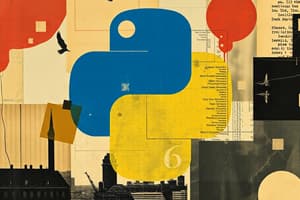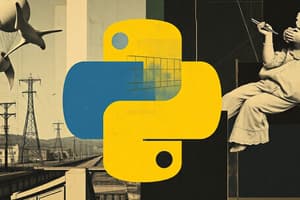Podcast
Questions and Answers
What programming paradigms does Python support?
What programming paradigms does Python support?
- Procedural, object-oriented, and functional programming (correct)
- All programming paradigms
- Functional and compiled programming
- Only procedural programming
Which of the following statements about Python variables is true?
Which of the following statements about Python variables is true?
- Variables do not require an explicit declaration (correct)
- Variables must be declared before use
- They support strict typing only
- Types must be specified during assignment
Which data structure in Python is ordered and mutable?
Which data structure in Python is ordered and mutable?
- Dictionary
- List (correct)
- Tuple
- Set
How is a function defined in Python?
How is a function defined in Python?
What is the purpose of the 'try' block in exception handling?
What is the purpose of the 'try' block in exception handling?
Which of the following libraries is primarily used for data visualization in Python?
Which of the following libraries is primarily used for data visualization in Python?
What type of collection is a tuple in Python?
What type of collection is a tuple in Python?
Which best practice should be followed for dependency management in Python projects?
Which best practice should be followed for dependency management in Python projects?
Flashcards are hidden until you start studying
Study Notes
Overview of Python
- High-level, interpreted programming language.
- Known for its readability and simplicity.
- Supports multiple programming paradigms: procedural, object-oriented, and functional programming.
Features
- Dynamic Typing: Variables do not require an explicit declaration to reserve memory space.
- Interpreted Language: Code is executed line by line, making debugging easier.
- Rich Libraries: Extensive standard libraries and modules, as well as third-party packages via PyPI.
- Cross-platform: Works on various operating systems (Windows, macOS, Linux).
Basic Syntax
- Variables: Assignment using
=, no need to declare types.x = 5 name = "Alice" - Control Structures: Includes
if,for,while.if x > 0: print("Positive") - Functions: Defined using the
defkeyword.def greet(name): return f"Hello, {name}!"
Data Structures
- Lists: Ordered, mutable collections.
my_list = [1, 2, 3] - Tuples: Ordered, immutable collections.
my_tuple = (1, 2, 3) - Dictionaries: Unordered collections with key-value pairs.
my_dict = {"name": "Alice", "age": 30} - Sets: Unordered collections of unique elements.
my_set = {1, 2, 3}
Object-Oriented Programming (OOP)
- Classes: Blueprint for creating objects.
class Dog: def bark(self): return "Woof!" - Inheritance: Mechanism for deriving classes from existing ones.
- Encapsulation: Restricting access to certain attributes and methods.
Exception Handling
- Use
try,exceptblocks to handle errors gracefully.try: result = 10 / 0 except ZeroDivisionError: print("Cannot divide by zero!")
Popular Libraries
- NumPy: Numerical computing and handling arrays.
- Pandas: Data manipulation and analysis.
- Matplotlib: Data visualization.
- Requests: Simplified HTTP requests.
- Flask/Django: Web development frameworks.
Best Practices
- Follow PEP 8 style guide for readable code.
- Use virtual environments for dependency management.
- Employ version control (e.g., Git) for project management.
- Write unit tests to ensure code reliability.
Common Use Cases
- Web development, data analysis, artificial intelligence, automation, and scripting.
Learning Resources
- Official Python documentation.
- Online courses (e.g., Codecademy, Coursera).
- Community forums (e.g., Stack Overflow, Reddit).
Overview of Python
- Python is a high-level, interpreted programming language known for its readability and simplicity.
- Python supports multiple programming paradigms, including procedural, object-oriented, and functional programming.
Features
- Python uses dynamic typing, meaning you don't have to explicitly declare variable types.
- Python code is interpreted, which means it is executed line by line, making debugging easier.
- Python boasts rich libraries, including extensive standard libraries and modules along with access to third-party packages via PyPI.
- Python is a cross-platform language, meaning it can be used across various operating systems like Windows, macOS, and Linux.
Basic Syntax
- Variables are assigned using the
=operator, and types do not need to be declared. - Control Structures include
if,for, andwhilestatements for controlling program flow.. - Functions are defined using the
defkeyword.
Data Structures
- Lists are ordered, mutable collections of elements.
- Tuples are ordered, immutable collections.
- Dictionaries are unordered collections that store key-value pairs.
- Sets are unordered collections that contain unique elements.
Object-Oriented Programming (OOP)
- Classes are blueprints for creating objects.
- Inheritance allows classes to inherit properties and methods from parent classes.
- Encapsulation restricts access to certain attributes and methods within a class.
Exception Handling
try,exceptblocks are used for handling errors gracefully.
Popular Libraries
- NumPy is used for numerical computing and array handling.
- Pandas is used for data manipulation and analysis.
- Matplotlib is used for creating data visualizations.
- Requests is used for making HTTP requests.
- Flask/Django are popular frameworks for web development.
Best Practices
- Follow PEP 8 style guide for writing readable code.
- Create virtual environments for dependency management.
- Use version control tools (e.g., Git) for project management.
- Write unit tests to ensure code reliability.
Common Use Cases
- Python is commonly used for web development, data analysis, artificial intelligence, automation, and scripting.
Learning Resources
- The official Python documentation is a great starting point.
- Online courses from platforms like Codecademy and Coursera provide structured learning.
- Online communities like Stack Overflow and Reddit offer support and resources for troubleshooting.
Studying That Suits You
Use AI to generate personalized quizzes and flashcards to suit your learning preferences.




